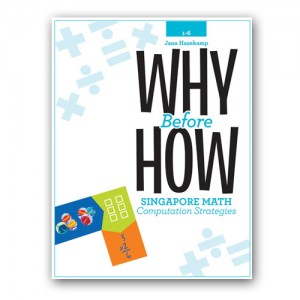A Good Introduction to Singapore Math
Why Before How: Singapore Math Computation Strategies
by Jana Hazekamp
(Crystal Springs Books, 2011 – Learn more)

Jana Hazekamp’s Why Before How, Singapore Math Computation Strategies is an accessible introduction to some key Singapore math strategies.
The author focuses on the use of the concrete-pictorial-abstract (C-P-A) approach to promote deep understanding. The use of manipulatives (the concrete aspect of the approach) and visuals (the pictoral aspect) to foster mathematical understanding is the heart of the book (although it is worth noting that the book does not cover bar models, another Singapore math hallmark).
The author makes explicit for teachers and students the connections across the C-P-A approach as well as across strategies that will also further concept development. She provides detailed examples that teachers would find easy to replicate in their own classrooms. For teachers who have not used these tools before but want to give them a go, this is a great place to start.
Inside the book

Hazekamp includes excellent examples of questions that teachers might use to probe and extend student thinking, such as “What did you do to solve this problem?”, “Why did you do it that way?” and “Is there another way to solve this problem?” She encourages teachers to celebrate the diversity in students’ approaches.
Throughout the book, the author also builds and models correct use of mathematical vocabulary. At the end, there is a handy reproducible word wall and a list of Common Core standards addressed.
The book is well organized with an introduction in which the author explains why she’s come to use Singapore math in her own classroom, even though her school has not adapted a Singapore math curriculum. Each of the remaining chapters is devoted to one mathematical operation – addition, subtraction, multiplication and division. Hazekamp proposes a sequence for teaching the strategies and provides a detailed example of how each strategy, including a sketch of the manipulatives or drawing, could be taught. Each lesson ends with suggestions for extension to other concepts such as decimals, time, and fractions.
One nit to pick
If I had to pick a nit with the book, it would be that it is too teacher-centric. Each strategy includes a “guided conversation” but it seems to be more of a teacher monologue. Lessons begin with the teacher telling the students the strategy through modeling and think alouds. At one point, Hazekamp suggests letting the students “discover” rather than providing them all the information, but that is not the overarching approach of the book.
In a recent Edutopia article, Jennifer Bay-Williams noted that in effective math instruction, helping students doesn’t mean showing them how. Students need to struggle and that seems to be missing in these instructional strategies. Teachers who use the strategies outlined in the book to guide students’ discovery, allowing them to struggle, are likely to be the most effective.
Some ideas about adding technology
Although technology integration is outside the scope of the book, as I was reading I couldn’t help but think about how technology could support learning, particularly in the pictorial phase. So, for no extra cost, I’ll share my ideas.
Hazekamp’s detailed examples could easily be made into interactive whiteboard lessons, where teachers have access to that technology. For classrooms with iPads or tablets, apps such as Motion Math Hungry Fish, Number Bonds Addition and Subtraction, and Number Bonds Multiplication and Division allow students to practice number bonds in various and engaging ways.
Virtual base ten blocks such as Number Pieces or Base Ten Numbers allow students to work with higher numbers that become cumbersome with real base ten blocks. Students could use whiteboard apps such as Educreations or ShowMe to draw and record and share their thinking.
More math engagement, better math thinking
I recommend Why Before How for upper elementary teachers (grades 3-6) who want to incorporate the C-P-A approach into their own teaching. The strategies are classroom-ready and can be implemented regardless of the textbook or curriculum that a teacher may be using. Like Hazekamp, I believe that by using Singapore math strategies, teachers will find their students will have a better attitude toward math, will be more engaged, and ultimately will be better mathematical thinkers – which is what math teaching is all about.
Jennifer Underwood, an elementary school teacher and former diplomat, taught fourth grade in an international school in Seoul, South Korea that adopted a Singapore math curriculum. She recently moved to Geneva, Switzerland where she is working as a high school librarian. One of her favorite projects was collaborating with other teachers and students to integrate research skills, social studies and technology to provide additional information to museum visitors at Underwood Memorial Hall.


































